Notes
The small town of Blue Rapids in northeastern Kansas only had a populaation of ±1000 people from 1890-1920, but during that period it supported an extraordinary number of photography studios, usually more than two that were in business at any one time.
And starting at least as early as 1893, at least one of those photography studios was run by a woman.
Incredibly, I have amassed a list of 18(!) women who were involved in the business of photography in Blue Rapids during that period. The ones marked with a “*” definitely ran their own studio at some point; the rest at the very least worked in studios in Blue Rapids (for some, I have not yet found evidence for their entire careers, so they may have run their own studios elsewhere).
- *Gertrude Axtell
- Della Blomberg
- Miss Carr
- *Evia Chaudet
- *Emma Collis
- *Florence (Kittie) Durkee
- Jennie Giltner
- Florence Greer
- *Gertrude Haun
- Gertrude Hubbard
- Nellie Lea
- Lila Leppard
- *Ada McAllister
- *Florence Miller
- Geneva Moxley
- *Della Riddle
- *Edith (Daisy) Roche
- *B. Schrebe
I’ll introduce you to all of these women, starting today with the ones who were active prior to 1903. We’ll meet the rest in another episode later this month.
Newpaper Ads and/or Photos
As mentioned in the episode, we have examples of newspaper adverisements for some of the different Blue Rapids Studios, plus a few examples of the photos produced by these photographers.
Many thanks to all the folks at the Blue Rapids Historical Society for their help in locating examples of the photos. The copies of the photos that are in the Blue Rapids Historical Society archive were provided by Tom Parker, a photographer currently working in Blue Rapids.
Chaudet Photo Company Ads
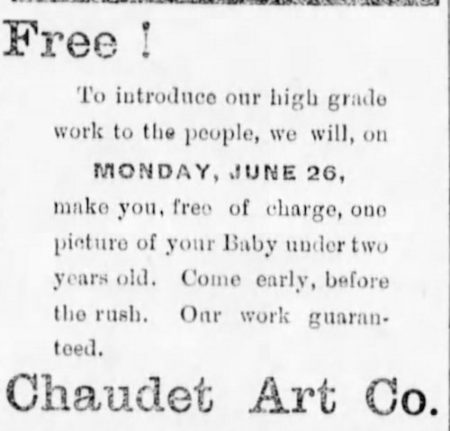


Wilson’s Gallery
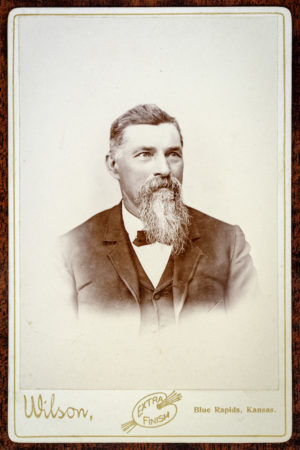
Miller’s Cottage Studio
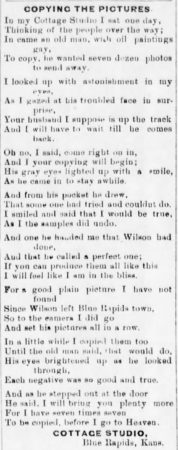
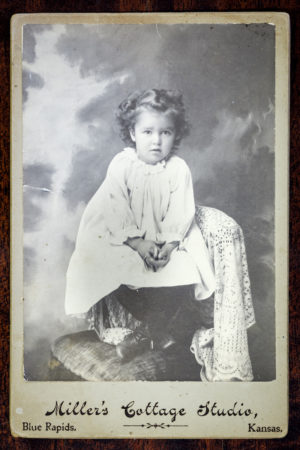

Mrs. McAllister’s Cottage Studio


Haun’s Art Gallery

Miss Durkee’s Art Gallery
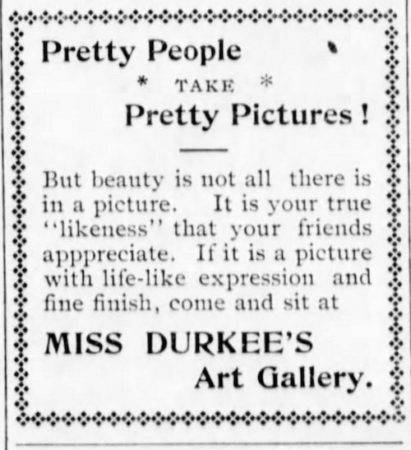

Florence (Kittie) Durkee also took photos for the newspaper. Here’s her photo from March 1903:
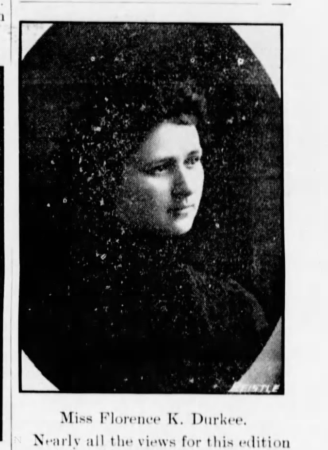
Recommended Links
- Tom Parker links
- Online research sites used for today’s episode
- Family Search website has U.S. Federal Census and more; free account required – Visit
- Ancestry.com (census records, city directories, and more; paid account required – Visit
- Geneologybank.com has a selection of digitized newspapers from the United States; paid account required – Visit
- Newspapers.com has a selection of digitized newspapers from the United States; paid account required – Visit
- Newspaperarchives.com has a selection of digitized newspapers from the United States; paid account required – Visit
Transcript
You’re listening to Photographs, Pistols, and Parasols.
Support for this project is provided by listeners like you. Visit my website at p3photographers “dot” net for ideas on how you, too, can become a supporter of the project.
Welcome to Photographs, Pistols & Parasols, the podcast where we celebrate early women artisan photographers.
I’m your host, Lee McIntyre.
Today I’m going to give you a quick introduction to 18(!) women who were involved in professional photography in the little town of Blue Rapids, Kansas starting in 1890.
For more information about any of the women discussed in today’s episode, visit my website at p3photographers.net. That’s letter “p”, number “3”, photographers “dot” net.
We’ve traveled today to Blue Rapids, Kansas, which is a small town in the Northeastern part of that state.
It’s a tiny town that has a small, central town square — which is actually a circle — with a handful of businesses that still ring the town green.
They also have a nice little historical museum there, too.
The population of Blue Rapids has never really reached 2,000; right now it’s around 1000 people, and in 1900 it was just a little bit more than that.
But there reason we’ve come to Blue Rapid today is because it’s really striking that between 1890-1920 there were always at least two photography studios in town — and during that period, at least one of them was always run by a woman.
There are really so many women connected with photography in Blue Rapids that it’s hard to know how to start.
I mean, I’ve compiled a list of 18 women who, starting in 1893, were involved in some way with photography running studios or working in studios.
There are many studios; as I said, almost always at least two simultaneously.
Some of those are run by women, some of them are consecutive chains of ownership, where the ownership passes from one woman to the next.
And, of course, that doesn’t include other studios that were there run solely by men.
Now the very first studio in town opened in 1871 when D.B. Taylor, a man who was noted as being the first “photographer and tonsorial artist” in town, opened his photography studio/barbershop.
There is a notice in the Blue Rapids Times paper in 1905 that commemorates that event.
The Blue Rapids Times newspaper has actually been digitized up until about 1925, which is great because we have a lot of information that we find in little nuggets about these women in the social notices, etc.
There’s a very active social life there in town.
But also in the notices about the studios and the women working at the studios, or the women running the studios.
Also, as we find with all the other women that we’ve discussed on the podcast, they are very active in the state photography organization, going to conventions every year, and traveling to the conventions with other photographers both from Blue Rapids and elsewhere in Kansas.
The digitized Blue Rapids Times newspapers have been a wonderful resource.
But I also want to thank the folks at the Blue Rapids Historical Society.
As I mentioned, Blue Rapids has a wonderful little historical museum, and the people in Blue Rapids have been so helpful and so generous with their time and efforts to track down the information about all these women photographers that I’m going to be talking to you about today and in the next episode.
I’d like so say a special thanks to Lori, Tom, Annette, Nancy, Pat, as well as everyone else tht we’ve t talked with at the Blue Rapids Historical Society and elsewhere in town.
Now, in terms of the photography that the women in Blue Rapids did, they ran studios and did the typical kinds of artisan photography that we find with all of the women that we’re talking about here on the podcast.
I mean, we find photos of babies and women and men … we find photos of places in town … there are school class photos … there are photos of just the town itself…
These photos were done as cabinet cards or CDV’s or used in the newspapers to be photos of people and places in town.
They were also reproduced as postcards.
It’s going to be impossible to cover all 18 of these women in depth without staying in Blue Rapids for the rest of the year.
So what I want to do today and in the next episode is to start to discover a little bit of their stories, to give you a sense of the rich history of early women artisan photography in Blue Rapids, Kansas.
Now the earliest evidence I have for woman photographers in Blue Rapids is a woman mamed Della Riddle.
There’s a notice in the newspaper in 1893 that she’s actually closing her studio in order to get married, to a man who’s a teacher, not a photographer.
He eventually becomes a minister.
In trying to trace whether or not she ever went back to photography after her marriage, I discovered that unfortunately she died quite young, in 1901.
She was survived by her husband and their young son, Fred.
Fred, sadly, is actually the first casualty in World War I from the Marshall County area, the county where Blue Rapids is located.
He’s buried with his mother in the cemetery there in Blue Rapids.
In any case, Delia Riddle is the first woman photographer that I have evidence for who ran a studio in Blue Rapids.
Well, that notice in 1893 when she’s selling her studio is actually more about the fact that another company is coming to town, a family of photographers, named Chaudet.
They open the Chaudet Art Company in Blue Rapids in 1893, taking out a big ad to proclaim that they are “here to stay”.
Well, they stay for a little while.
They actually take out ads advertising specials to get free photo of your baby and that kind of thing, just very typical kinds of the entrepreneurial ads.
But what’s interesting about the Chaudet Art Company is actually it’s run by a husband and wife; later they are joined by their son.
But the Chaudets, husband, Alfred, and his wife, Evia, are active as photographers in the Midwest not just in Blue Rapids, but all over the place.
They have galleries in Joplin, Missouri, and McCook, Nebraska, among other places.
In 1893 when they come to Blue Rapids, and take over the gallery that had been the place where Della Riddle had had her studio, well, they take over that gallery, but they actually are giving up the gallery that they had had in McCook, Nebraska, because they buy a photo car.
So they’re running multiple locations for their photography, and not just in Blue Rapids.
But we do have an example of their photography there in Blue Rapids.
It’s a wonderful head and shoulders portrait shot of a woman.
Which is interesting, because one of the things that they are very proud of later on in their careers is the fact that they are specialists in taking pictures of places, of views of the town … views of people’s ranches .. of their farms … and that becomes really their niche market circa 1900.
But as I mentioned, in 1893 they are in Blue Rapids, but they also had that photo car.
Now a photo car — I should maybe explain a little about that.
It’s a private railroad car.
It’s this idea that photographers had, to be able to go from town to town, have a portable studio so they didn’t have to rent space in every little town, but they could get the business in all these little towns that the train serviced.
In 1898 they take out some ads that have a wonderful sketch that has a lot of detail of the photo car itself.
You can see the outside, how it would have all this advertising on the outside.
This wonderful ad is very typical, because not only does it have a sketch of their photo car, but also proclaims, you know, we’re here in town for a few weeks.
And that’s exactly what these photographers would have done with these photo cars: take out ads saying we’re coming to town, then take an ad saying, hey, we’re here, come get your picture taken!
And then after a few weeks, they would move on to the next town.
But what’s interesting is that Chaudets actually ran this little mini empire, apparently, where they had physical spaces in some towns, like Blue Rapids, for a couple of years, but they also had this traveling photography studio, so they could actually maximize the number of people they could service.
Now the notices in the paper for the Chaudet Company also give mention of the fact that they are training people, they are taking on as assistants, who are learning on the job, as it were.
This includes one Miss Giltner, whose father or brother or somebody named “Mr. Giltner” also works for the Chaudet company.
Miss Jennie Giltner learns the trade so well that she’s actually able to take over at one point.
When the main operator there, a “Mr. Wilson”, goes off to a photography convention, the Chaudet studio is left with “Miss Giltner” in charge.
By sometime in the 1898 it would appear that the Chaudets are no longer in Blue Rapids, but I don’t have a notion of when exactly they leave.
It’s also not clear to me what the relationship was really between the “Mr. Wilson”, who worked at the Chaudet Art Company, and the two brothers named Wilson who ran a separate “Wilson’s Gallery” in Blue Rapids.
The Wilson’s Gallery in Blue Rapids had opened long before the Chaudets came to town.
There’s a notice in the paper in 1887 that the Wilson Gallery, operated by U.S. and E.R. Wilson, is now open.
But the Wilsons leave Blue Rapids by 1898.
It’s not clear that any woman ever worked at the Wilson Gallery, but I bring them up because they provide a link in the chain of studios that we’re talking about today.
You see, when they leave town in 1898, their very popular photography studio is taken over by the Millers.
Now the Millers are another husband and wife couple, like Chaudets.
The Millers, Robert and Florence Miller, take over the Wilson studio in 1898, and their ads initially refer to the fact that Wilson’s gallery was so popular, that they are offering just as good photography, so, come to them, they are just as good, you’re going to be just as happy with their photography you were with WIlsons.
So they rename the studio and call it the Miller’s Cottage Studio.
One thing that’s interesting is that one of the early notices in the paper, when they’re trying to get the business back from the Wilson Art Gallery, is to have this very unique kind of notice which is in the form of a poem.
And although the notices initially say that Robert Miller is the photographer, the poem actually makes it clear that Florence Miller is also a photographer.
Because the poem is written in the voice of a female photographer, specifically in the voice of a female photographer who’s also married to a male photographer.
In the poem, the woman (narrator) sort of laments about how when a Customer comes and thinks, oh, I can’t get my photo taken right now because your husband isn’t here. But she says, no, no, no, I’m a photographer, too, I can take a great photo … come on in and I’ll take your photos.
And then of course the Customer (in the poem) is happy that they (the Millers) are doing great work just like Wilson had been doing.
It’s really an interesting kind of advertising approach, because it’s very long advertisement, written in verse.
But anyway, that’s 1898 when the Millers come to town.
In 1901 the Millers leave Blue Rapids, and they sell the Cottage Studio a woman named Mrs Ada McAllister.
The notice n the newspaper, when Mrs McAllister takes over, emphasizes that she has hired an experienced photographer named Miss Carr who is going to be assisting her.
Miss Carr comes from Chicago.
It’s kind of an interesting notice, and I think it’s easily explained when we look into Mrs McAlister’s background.
Because it turns out that she really wasn’t a photographer before she bought that studio in 1901.
She was from Kansas, and she had married in 1873.
But unfortunately — and very tragically — her husband dies less than a year after they get married.
He dies in 1874.
His obituary says he dies from consumption.
But she’s in Blue Rapids working as a milliner, running a very popular millinery shop with at least one of her sisters.
That’s in the mid to late 1870s.
But then, in the 1880s, one of her sisters in Blue Rapids gets married and moves with her husband to Texas.
And Mrs Ada McAllister moves with them.
While Mrs McAllister is in Texas, she actually seems to remake herself as an artist.
And so she starts billing herself in the Dallas city directory as an “artist”.
She’s teaching painting there as well.
But she’s not not doing photography.
Which is why it’s a bit of a surprise that she up and buys that studio in 1901 from the Millers.
But one of her sisters was still in Blue Rapids, so maybe she wanted to move back to Blue Rapids, and this was the business opportunity that was at hand.
By 1902 Mrs McAllister seems to be comfortable in being a photographer on her own because she no longer mentions that Miss Carr from Chicago.
Rather, the ads are all about having your picture taken by “Mrs McAllister, Artist.”
So by 1902, as I said she’s really comfortable selling herself as a photographer
Now interestingly, though, she only lasts in Blue Rapids as a photographer until 1903.
It’s long enough that she’s able to teach some other women photography, like a MIss Nelly Lea, who works with Mrs McAllister for awhile.
But then, in March of 1903, she actually decides to sell the studio and go back to Dallas.
She sells the Cottage Studio to another woman, a woman named Miss B. Schrebe.
Miss B. Schrebe takes out a notice in the paper saying that she’s re opening the Cottage Studio, which she is now calling the Cottage Photo Studio, on March 10, 1903.
What’s curious is that I can’t find any other evidence for this Miss B. Schrebe.
And by August 1903, the Cottage Photo Studio was back to being named the Cottage Studio and it is being run by a man, a Mr D. L. Reed.
Miss B. Screbe disappears from the scene, and the Cottage Studio is, as far as I can, tell never again run by a woman photographer.
But that’s not the end to the women photography stories in Blue Rapids, of course.
As I said, there are always concurrent studios in town, and sometimes there were concurrent studios being run by women.
For example, if we go back to 1898, a woman named Gertrude Haun moves to Blue Rapids and opens up the Haun’s Art Gallery, which is a competitor of Wilson, and then Miller, and maybe Chaudet if they were still there in 1898.
The Haun Art Gallery opens with great fanfare in the paper in May 1898, with the slogan, “Haun Makes Faces!”
And indeed, in May 1898, there’s a great notice that Miss Haun was celebrating the opening of her new studio by taking pictures of 51 babies in one afternoon.
51 babies!
Now, when I read that I thought wow that is a lot of baby pictures to be taking in one afternoon, particularly with the kind of camera equipment that existed at that point, because it’s not like pulling out your cell phone and taking 51 pictures of a baby.
But when I was talking to someone at the Blue Rapids Historical Society about that notice, I was struck by the fact that they were 51 baby pictures that had to be made in a single day.
And she said she was struck by the fact that there were 51 babies that Miss Haun had found to take pictures of!
Which that’s a good point; in a town that only has 1000 people, where do you find 51 babies to take pictures of in a single afternoon?
So Miss Haun sets up shop in 1898, and throughout her tenure in Blue Rapids she’s very active in the town.
She has an assistant, initially, a Miss Gertrude Axtell.
Unlike Mrs McAllister’s original ad, though, the newspaper notice didn’t doesn’t say that Miss Axtell was particularly experienced.
And indeed, Gertrude Haun had been a photographer for a couple of years before she moved to Blue Rapids in 1898.
Now Miss Haun is passing that on, working first with Gertrude Axtell, later working with another woman named Miss Delia Blomberg, but then also working with a woman named Gertrude Hubbard.
Gertrude Hubbard has an interesting life story, and I want to take just a little side-step into her story for the moment.
Miss Gertrude Hubbard starts as a librarian; well she’s an assistant librarian, but then around 1898 she actually is promoted to become a full-fledged librarian.
But just a couple of weeks later, there’s a notice in the paper that she’s resigned, and her position been taken by a woman named Miss Daisy Roche.
Miss Hubbard, instead of being a librarian, has apparently gotten a real interest in photography.
There is a great notice, again around 1898, that she’s kind of driving people crazy in town, because she has just gotten a new Kodak camera, and she’s going around taking snapshots of everybody!
But by 1900, she considers herself a full fledged photographer.
That year it’s in the paper that she is learning re-touching from Miss Haun, and also maybe assisting Miss Haun in general in her studio.
It’s not really clear — without any kind of business or city directory, we can’t really understand what Gertrude Hubbard was doing with her photography other than these little notices in the paper.
In 1904 she probably leaves photography behind, because she gets married to a dentist named Samuel Gilson.
Now I bring this up for a couple reasons.
One is that she’s happily married to Dr. Gilson for 20 years, but then he’s tragically killed in an automobile accident in 1925.
What was really intriguing discover — as a rabbit hole that I tried not to fall into too deeply! — is that he dies without a will, and so his estate has to go into probate.
And all of the documents regarding the probate of that estate for a couple of years are all online.
Which are really kind of fascinating to read, partcularly how Mrs Gilson is trying to figure out how to get money to support her and her three small children.
She’s not apparently doing photography by the time her husband dies, so I don’t think she actually did it after she got married.
But another little interesting rabbit hole, connected to Gertrude Hubbard Gilson, is actually not only was her husband, Samuel Gilson, a dentist, but her sister-in-law. a woman named Elnora Gilson Whitmore, well, she was one of the first female physicians there in Kansas.
She got her degree from a medical school in Chicago in the 1890s (which was one of the first to actually admit women and give them medical degrees).
Later she goes back to Blue Rapids and sets up a very popular medical practice.
Again, in the 1890s, much earlier than I really ever thought women did that kind of work.
So it’s not just women as photographers that nobody knows about, but I think it’s also women as physicians that nobody really knows about in these early days in the late 19th – early 20th centuries.
But in any case, getting back to MIss Haun and her studio …
Remember, Gertrude Haun was the woman who actually ran the studio we were talking about …
Miss Haun is in town, and she is taking pictures not only of the babies, but also pictures of adults, and couples, and women, and men, and business people, and also high schools.
In fact, the high school graduating class in 1900 had their picture taken by Gertrude Haun.
Gertrude Haun has a problem in 1902, when her sister-in-law, who is in Tennessee, dies.
And so Gertrude Haun needs to go to Tennessee to help her brother out.
And so she sells her studio to the woman who is her assistant at that time, woman named Florence Durkee, or as she was known in town “Kittie” Durkee.
Kittie Durkee had been Miss Haun’s assistant in the Haun studio.
When she buys the studio, she renames the studio, rightly enough, as “MIss Durkee’s Art Gallery”.
And then starts to take out ads, saying
Pretty people take pretty pictures but beauty is not all there is in the picture. It is your true “likeness” that your friends appreciate. If it is a picture with life-like expression and fine finish that you want, come and sit at Miss Durkee’s Art Gallery.
Alright, so those are her ads throughout the summer of 1902. But then in July of 1902 she actually puts out a different notice, saying that she’s going to close her shop for a month, she’ll be back at the end of August.
She’s going to go off to visit relatives for the month.
Now, remember in 1902 Mrs McAllister was running the Cottage Studio there in town, and her ads were always about the kinds of pictures that you could have taken at Mrs McAllister studio.
But in August of 1902 — which is a moment when Florence Durkee is off on her vacation — Mrs. McAllister takes out a striking ad saying that the only photographer in Blue Rapids is Mrs McAllister at the Cottage Studio.
Now, I don’t know if they were other competitors in town at that point, or if it was just Miss Durkee and Mrs McAlister.
But it’s really striking that Mrs. McAllister figures out that every other photographer is gone, and so she’s the only one in town.
But it is really that she’s the only one in town at that particular moment.
Because of course Miss Durkee was coming back; she was only on vacation.
So when Miss Durkee comes back, she takes out a new approach to her ads, to have more thematic things … to have specials to draw people back in, to say, Hey, I’m still here!
One of those is something she declares to be Grandmother’s day in October of 1902.
She offers a free cabinet card to every grandmother.
There are big notices in the paper.
And then there’s a nice little write-up after after Grandmother’s Day, which was October 30, 1902 at Miss Durkee’s gallery.
The write-up says Miss Durkee was at the camera, and her assistant, Miss Roche, was there to receive the customers as they came in the door.
Now Miss Durkee’s assistant — that “Miss Roche” — that’s actually the same Miss Daisy Roche who became the librarian when Gertrude Hubbard gave up that job.
So it is really interesting that there’s this path from librarian to photographer there in Blue Rapids.
Now Miss Durkee also does photography work that winds up in the newspapers.
In 1903 we have examples of work that Miss Durkee did for the newspaper, the Blue Rapids Times.
There’s a big article — actually it’s like the whole edition of the paper (it’s only eight pages) — on the town and the townspeople, i.e. the prominent people that people need to know or are interested in finding out about.
There are photos of a lot of these business people in town, including MIss Durkee.
Not only that, it says that MIss Durkee took all the pictures — or almost all the pictures — for that particular edition of the newspaper.
So that’s really fun to find, because it’s something a little bit different from the cabinet cards and things.
Although, the picture of MIss Durkee is like standard head and shoulders shot.
But what’s fun is like it’s a “selfie” of MIss Durkee.
Anyway, I’ll include that and that page from the newspaper in the episode notes you can see some of her photography work
She actually gets very active in photography for many years.
She opens up a gallery in Frankfort, Kansas … she goes to Topeka … she goes the conventions a lot … she’s traveling around with various people.
But then in 1909 she up and sells her studio — which is that point in Frankfort, Kansas — and turns to more Christian missionary work, and that consumes the rest of her adult life.
But while she’s active as a photographer in Frankfort, Kansas for five years, she’s only in Blue Rapids for a couple of years, though, before she sells her studio — in September 1903 — to her assistant, her assistant being that woman that I mentioned, Miss Daisy Roche.
When Daisy Roche took over that studio in 1903, it was the start of very long career.
The “Roche Studio”, or variations on that name, was in business from 1903 into the 1950s.
During those decades, Daisy Roche’s story involves a variety of photographers, and even her sister, Emma Roche Vaughn Collis.
There’s a lot to talk about for the Roche studio, and I’m going to save that for the next episode, which is going to be Part Two of the women photographers of Blue Rapids, Kansas.
Before I end today, though, I want to thank once again all the wonderful people in Blue Rapids.
I’d like to a give special shout-out to Lori Parker and her husband, Tom Parker, for organizing a wonderful day for my husband, Chris, and I.
Lori not only brought together people in town to come talk to us about their memories of some of these women photographers, but she also organized a couple of special field trips in town, and also coordinated us diving into the archives at the museum and library, where we uncovered artifacts, photos, and newspaper articles that have not yet been digitized.
Lori’s husband, Tom Parker, is himself a photographer. Tom’s provided some wonderful digitized images of the photos that we found done by the women of the Blue Rapids studios.
I’ll be sharing those in the episode notes for today’s episode.
I’ll also provide a link to Tom’s own website so you can see his fabulous photos of Kansas and beyond, plus you can grab a copy of his wonderful book about modern-day life in the tiny town of Blue Rapids, Kansas.
The episode notes for today will also include some examples of the newspaper ads I mentioned, but that photo of Kittie Durkee that was in the newspaper.
As always, the episode notes for today’s show will be available on my website at p3photographers.net.
Or you can drop me a line, at podcast “at” p3photographers.net.
Or follow me on Facebook, at facebook.com/p3photographers.
Support for this podcast is provided by listeners like you.
For ideas on how you, too, can support the project, go to the website at p3photographers.net.
Next time, we’ll still be Blue Rapids, exploring the wonderful world of the Roche studio.
Until then, I’m Lee McIntyre, and this is Photographs, Pistols & Parasols.
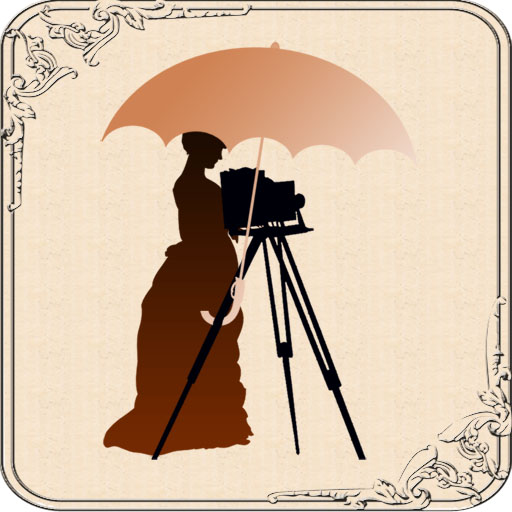
2 thoughts on “19-The Women of Blue Rapids, Part One”
Comments are closed.